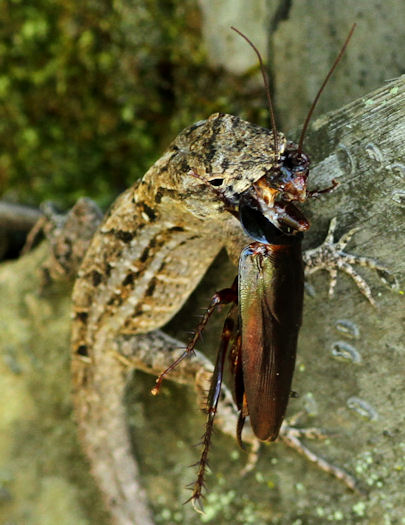 Woo-hoo! Check out these anole beauties. And the green one actually has a red dewlap and looks passably like Anolis carolinensis. Google “plush anole” or “glitter anole” and you can have your own–for as little as eight buckaroos.
Woo-hoo! Check out these anole beauties. And the green one actually has a red dewlap and looks passably like Anolis carolinensis. Google “plush anole” or “glitter anole” and you can have your own–for as little as eight buckaroos.
But there’s a backstory. Over the years, two undergraduates who worked in my lab each gave me a plush anole as a thank you present when they graduated. One day I was talking on the phone and idly picked up one of the stuffed fellows. Still attached to it was the information tag. And as I opened the tag, which contained natural history information, reasonably accurate, on A. carolinensis, I was amazed to see this:
No doubt, you can see one cause of my amazement. That’s no Carolina green anole, but rather its ecomorphic döppelgánger from Hispaniola, A. chlorocyanus. And, moreover, that’s not just any photo of a Hispaniolan green–that’s my photo! And, as you might have guessed, used without permission.
Incensed, I looked to the bottom of the tag for the company that makes the toy, Fiesta Toys. I looked them up online and went to their contact page. I filled in the little box on the page, noting that they had used my intellectual property without my permission. I pushed “send,” figuring I’d never get any response, much less satisfaction.





 This, in turn, reminds us of
This, in turn, reminds us of 

 Periodically, we’ve discussed how green and brown anoles interact now that they’ve been thrown into sympatry in the southeastern U.S. and elsewhere–do they
Periodically, we’ve discussed how green and brown anoles interact now that they’ve been thrown into sympatry in the southeastern U.S. and elsewhere–do they 
 With regard to anoles, Vanzolini made two important contributions in collaboration with Ernest Williams. The first was their
With regard to anoles, Vanzolini made two important contributions in collaboration with Ernest Williams. The first was their 

